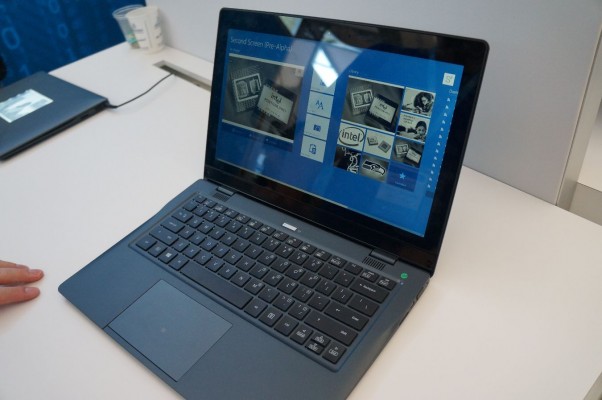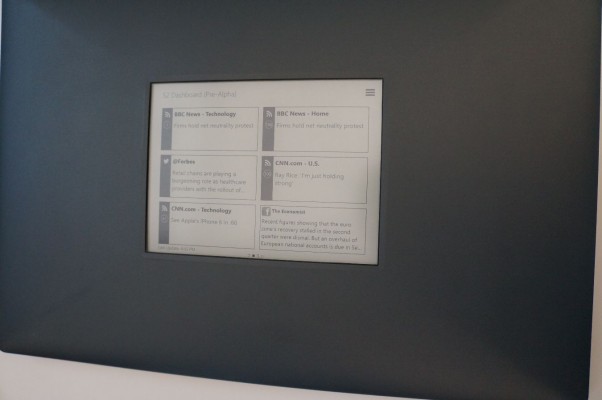Intel Shows Off Laptop With Second, E Ink Screen on Lid
SAN FRANCISCO -- For years, we've seen the PC industry's half-hearted, mediocre attempts to build a laptop with a second display, from the tiny color touchscreen in the deck of the Fujitsu LifeBook N7010 to the Lenovo ThinkPad W700ds and its 7-inch, pop-out screen, but none of these attempts caught on. However, at IDF 2014, Intel made the case for a second laptop screen as clear as black and white or at least a few shades of gray. In a quiet corner of the Moscone center, the chipmaker showed off a new prototype laptop with a small, touch-sensitive E Ink display built into the back of the lid.
As we watched, Intel Software Engineer Taylor Courier demonstrated the rear panel's ability to display updated newsfeeds, show photos or help conduct a foreign-language conversation. Courier started his demo by opening a control application which is meant to control the content of the E Ink panel.
The most basic use case, he said, is simply displaying a static image on the second screen. A photo he selected appeared in seconds and looked sharp and detailed despite the grayscale display; even a webcam photo he took of our face looked remarkably lifelike. He then showed a feature of the application which lets you enter text and display it on the rear panel, typing "Hello IDF Viewers!" and hitting an on-screen button to submit it.
He then opened a demo translator app, typed in a phrase in English, selected Spanish as a destination language and hit submit, causing a translated version of the phrase to appear on the E Ink panel. Theoretically this feature could be used to "say" things to a foreign language speaker sitting across from you, but it seems a little rude and only works well if your conversation partner also has a notebook and types a response back to you using this app. We'd rather show PowerPoint slides or sample web pages to the person sitting across from us and, though the prototype laptop didn't have this ability, Courier said it would be easy to enable that kind of screen sharing with a future SDK.
MORE: 12 Gadgets Ahead of Their Time
Looking at photos, text messages or even foreign-language phrases could be helpful, but the best use of the second screen is as an up-to-date alert system. As we watched, Courier touched the E Ink display which launched a menu he used to navigate to a dashboard, filled with several tiles with up-to-date data feeds. He explained that some feeds contain stock quotes, others contain weather, others show a list of tweets from a user or hashtag and still others show RSS newsfeeds. When he tapped on an individual RSS feed, it brought up a list of headlines and, when he tapped a headline, he got a short summary of the article.
Though not enabled on the prototype we saw, Courier said that the technology could support email alerts, social media notifications or even incoming Skype calls. Even while asleep, the laptop remains in connected standby mode, pulling down updates every 15 minutes and refreshing the panel accordingly. Just imagine pulling your laptop out halfway out of your bag and seeing that you got an important email from the boss, before you've even opened the lid.
Sign up to receive The Snapshot, a free special dispatch from Laptop Mag, in your inbox.
Because the second panel is E Ink, it uses no power to maintain the picture and consumes just a little bit of juice "listening" for touch input or refreshing with new content. The impact on battery life could be negligible or, it could save you some power, if you end up seeing a notification on the lid rather than waking the whole system.
MORE: Most Important Moments in Computing History
Intel's second screen prototype reminded us a lot of the YotaPhone smartphone which has a second, ePaper display on its backside for showing alerts, displaying photos or holding post-it notes However, YotaDevice's solution is currently limited to its one phone. With Intel leading the way, the second screen could go mainstream on laptops from leading vendors.
Unfortunately, the laptop we saw was simply a prototype and there's no guarantee that Intel will take the technology to market or convince its partners to give second screens a try. However, with PC vendors desperate to convince users to upgrade their old laptops, implementing a second display makes a lot of sense. In a market where many consumers still aren't excited by 2-in-1s, this tiny panel provides a potentially disruptive change to the traditional clamshell notebook, turning it into an always-on device that provides alerts much like a phone does.




